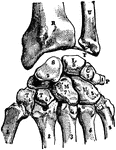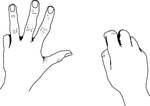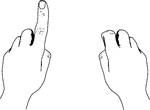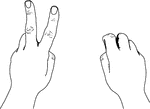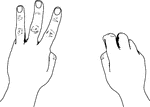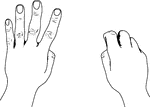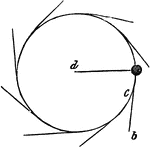
Centrifugal Force
"Suppose a cannon ball, tied with a string to the centre of a slab of smooth marble, and suppose an…

Third-class Lever
"In the third and last kind of lever, the weight is placed at one end, the fulcrum at the other end…
Form of Waves
"Tie one end of a soft cotton rope about 20 feet long to a fixed support, and hold the other end in…
Fixed Wave Reflection
"Suport a soft cotton rope several yards long between two fixed supports, as the opposite sides of the…
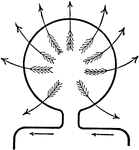
Magnetic Field Around a Current Carrying Wire
"If the conducting wire is bent into the form shown, the lines of force will pas around the wire from…

Arm Bones
Demonstration of the movement of a pivot joint. Labels: A, arm in supination (palm uppermost); B, arm…
Arm Muscles
The muscles on the back of the hand, forearm, and lower half of the arm, as exposed on dissecting away…
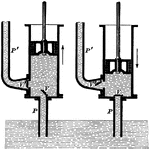
Forcing Pump
"As the piston ascends, as shown in the left-hand figure, the pressure of the atmosphere forces the…
!["A double-acting pump of the piston pattern is shown [here]. Such a pump has two sets of suction valves and delivery valves, one set for each side of the piston. With the piston moving in the direction of the arrow, the pressure of the atmosphere forces the water up the suction pipe P into the left-hand end of the pump cylinder, the left-hand suction valve opens and the left-hand delivery valve is closed...The water now flows up the delivery pipe P'." —Hallock 1905](https://etc.usf.edu/clipart/36100/36170/2act_fpump_36170_mth.gif)
Double-acting Force Pump
"A double-acting pump of the piston pattern is shown [here]. Such a pump has two sets of suction valves…
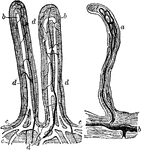
Small Intestine Villi
Villi of the small intestine, magnified about 80 diameters. In the left-hand figure the lacteals, a,b,c,…
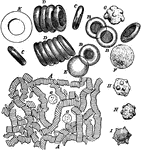
Blood Cells
Blood corpuscles. Labels: A, magnified about 400 diameters. The red corpuscles have arranged themselves…

Circulation in a Frog's Foot
Circulation in frog's foot under a microscope. Labels: A, walls of capillaries; B, tissue of web lying…
!["... balance a card with a penny placed upon it on the tip of one of the fingers of the left hand, and strike it suddenly with the middle finger of the right hand, as represented [here]." —Quackenbos 1859](https://etc.usf.edu/clipart/36300/36306/inertia_dem2_36306_mth.gif)
Inertia Demonstration
"... balance a card with a penny placed upon it on the tip of one of the fingers of the left hand, and…
!["[This illustration] shows the path of a stone thrown obliquely from the hand. The propelling force sends it in a straight line to A, and would take it on in the same direction to B, were it not that, as soon as its velocity becomes sufficiently diminished, gravity and the air's resistance give it a circular motion to C, and finally bring it to the earth at D." —Quackenbos 1859](https://etc.usf.edu/clipart/36300/36322/proj_mot_36322_mth.gif)
Projectile Motion of a Stone
"[This illustration] shows the path of a stone thrown obliquely from the hand. The propelling force…

Steelyard
"The steelyard is a kind of balance, which, though not so sensitive as the one being described above,…
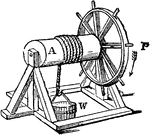
Wheel and Axle with Spokes
"Instead of having a rope attached to it, the wheel is often provided with projecting pins, as shown,…
!["[This illustration] shows a third form of the wheel and axle. Here the axle A is vertical, instead of horizontal. A bar inserted in its head, at the extremity of which the hand is applied, takes the place of the wheel." —Quackenbos 1859](https://etc.usf.edu/clipart/36300/36346/vert_whax_36346_mth.gif)
Vertical Wheel and Axle
"[This illustration] shows a third form of the wheel and axle. Here the axle A is vertical, instead…

Muscles on the Back of the Arm, Forearm and Hand
The muscles on the back of the arm, forearm and hand.

Pacinian Corpuscle
A Pacinian Corpuscle, one of the organs of touch in the skin, which is composed of lamellae (3), consisting…
Forearm and Hand
Deep dissection of the front of the forearm and hand, showing the muscles, nerves, blood vessels, etc.…

Bones of the Arm and Hand
Bones of the arm and hand. Labels: a, large end of ulna; b, radius; c, small end of the ulna; d, carpal…

Bones and Ligaments of the Hand
Bones and ligaments of the hand. There are 27 bones in all, including 8 small bones called the carpal…

Silver Half Dime Coin, 1837
Half Dime (5 cents) United States coin from 1837. Obverse has right-facing Liberty seated beside a shield…

Silver Fifth Dollar Coin, 1875
Fifth Dollar (20 cents) United States Coin from 1857. Obverse has the image of Liberty beside a shield…

Silver Quarter Coin, 1853
Quarter (25 cents) United States coin from 1853. Obverse has the image of a Liberty seated beside a…

Silver Half Dollar Coin, 1853
Half Dollar (50 cents) United States coin from 1853. Obverse has the image of a Liberty seated beside…
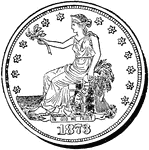
Silver Trade Dollar Coin, 1873
Trade Dollar ($1.00) United States coin from 1873. Obverse has a seated, left-facing Liberty holding…
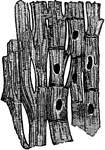
Cardiac Muscular Tissue
Cardiac muscular tissue, magnified about 400 diameters. The cell-boundaries and cell-nuclei are indicated…

